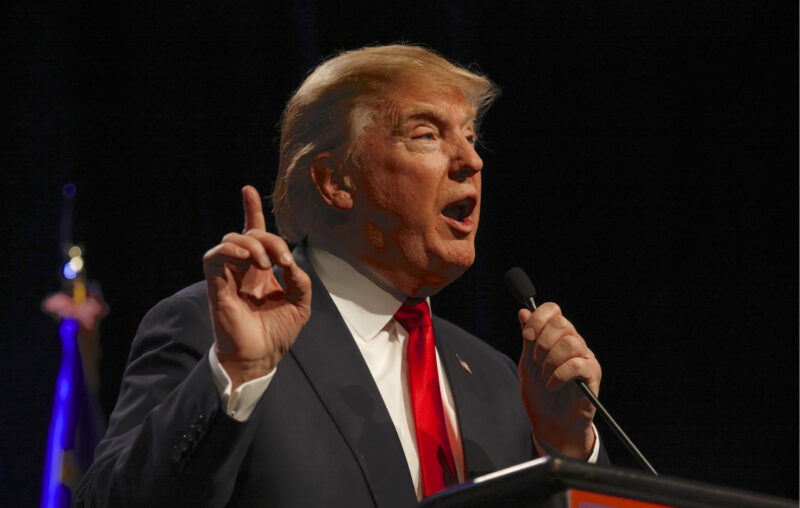Debt, Deficits, and the Donald

Speaking to a CNBC reporter back in January, White House aide Larry Kudlow boasted about economic growth under President Trump (and blamed the Fed and others for its not being even higher): “You’ve gone from 1.5 percent to 2 percent growth. We had it going at almost 4 percent, then the Fed tightened. . . . We’re now down to 2.5 percent to 3 percent. I’m looking for faster growth.”
Kudlow was correct to prioritize economic growth. In a paper for the Mercatus Center, William Beach and I noted that if the economy were to grow at an inflation-adjusted rate of only 2 percent, it would take 35 years for the size of the economy to double. Three percent growth would double the economy in 23.5 years, and 4 percent growth would achieve that in less than 18 years.
The opportunity cost of slower growth has also been widely documented. As Hoover Institution economist John Cochrane has summed it up: “If the US economy had grown at 2% rather than 3.5% since 1950, income per person by 2000 would have been $23,000 not $50,000. That’s a huge difference. Nowhere in economic policy are we even talking about events that will double, or halve, the average American’s living standards in the next generation.”
So, yeah, economic growth is a big deal. The good news is that we know how to promote it. The building blocks of economic growth are property rights, the rule of law, and sound money. While far from perfect on these fronts, the U.S. is in relatively good shape. Additional causes of growth include less burdensome taxes, less regulation, and — contrary to conventional wisdom — substantial spending restraint.
Republicans love to focus on the tax part. Tax cuts as economic and political salvation have been a core tenet of Republican dogma since the 1980s, when Jack Kemp likened selling voters on cutting spending to selling them on a root canal. He suggested that GOPers instead focus on cutting taxes as a way of both growing the economy and reducing deficits and debt. Grover Norquist, president of Americans for Tax Reform, has said on multiple occasions that “Republicans have been put on earth to cut taxes.” Indeed, many GOP candidates just finished campaigning on Trump’s signature tax cut and warning that Biden and his fellow Democrats would raise taxes.
But Republicans’ singular obsession with cutting taxes obfuscates a profound truth: If you cut taxes but continue to spend excessively, the result is debt, debt, and more debt. And unless the cuts allow revenue to grow faster than debt (wishful thinking), the pressure to impose growth-inhibiting tax hikes or monetary shenanigans only intensifies. Milton Friedman often counseled, “Keep your eye on one thing and one thing only: how much government is spending, because that’s the true tax.” Unfortunately, on this front, Republican administrations and Congresses have utterly failed.
When Democrat Bill Clinton left the White House — and congressional Republicans at least pretended to care about federal spending — gross federal debt was close to $6 trillion in nominal terms (55 percent of GDP), and the budget was balanced. The end of the Cold War and a booming economy had reduced for both parties the urgency of fiscal policy. But in hindsight, it’s clear those were the good old days. By the time Clinton’s successor, Republican George W. Bush, had left the White House eight years later, the national debt was around $12 trillion (82 percent of GDP). And when his successor, Democrat Barack Obama, left office another eight years after that, the debt had risen to around $20 trillion (over 100 percent of GDP).
This debt explosion happened even though, during the 16 years under Bush and then Obama, Republicans enjoyed more congressional majorities than Democrats. But the Obama administration and congressional Democrats have been just as complicit. And the Democratic agenda has arguably never been more fiscally radical — more insistent on growing government’s size and scope — than it is now, as Joe Biden prepares to move into the White House. But here’s the difference: Democrats have been mostly honest about their desire to grow the government. Republicans have generally been — to put it politely — hypocritical.
Hypocritical, that is, until the Donald. He never even pretended to be a small-government Republican. On the campaign trail he joked about being the “king of debt” — though he doesn’t like paying interest on that debt — and called for willy-nilly military-spending increases. He also was honest about his refusal to touch Social Security and Medicare, our two biggest entitlement programs and two of the three main drivers of our indebtedness (the third is Medicaid). As a result, annual government spending just before the coronavirus pandemic was $1 trillion higher than it had been when Obama left office, and the budget deficit was on track to hit $1 trillion despite a historic economic boom.
Unsurprisingly, when COVID-19 hit, politicians on both sides of the aisle tripped over themselves to fling at the problem as much money as they could grab, without taking a moment to think seriously about what the best course of action might be. The result was a massive $2.2 trillion relief package, passed in March with the full support of the White House.
One can easily understand the impulse. Within a matter of days, the U.S. was hit with a deadly pandemic, businesses closed everywhere, the unemployment rate rocketed above 14 percent, and growth collapsed. It was necessary to put the economy on life support. Today, however, the unemployment rate is down by more than half, the economy is growing again, and businesses across the country are reopening their doors. The White House is nevertheless negotiating with Nancy Pelosi for another relief package of $1.8 to $2 trillion, which would include many programs that have proven counterproductive, such as an unemployment-insurance bonus, and other crony programs, such as additional bailouts for airlines. With Republicans like these, who needs Democrats?
So what now? After conducting a presidential campaign that was utterly silent on the national debt, President Trump has lost, and President-elect Biden will likely face a Republican Senate. The good news is that when the Democrats hold the presidency, Republicans tend to remember their talking points about small government and the need to reduce the deficit and the debt. After Barack Obama was elected president, sweeping Democratic control of Congress in with him, big-spending Bush Republicans vigorously attacked (rhetorically, at least) our mounting debt. They even made cutting spending the central talking point of their successful 2010 campaign to retake the House of Representatives. And they certainly deserve credit for making it impossible for Democrats to implement some of their most left-wing policies.
The same should prove true this time around. Fortunately, divided government will mean no Green New Deal, no federally mandated and funded paid leave, and no Court-packing. But it probably won’t mean less spending. We saw in 2013 that House Budget Committee chairman Paul Ryan was willing to make a reckless budget deal with Democratic senator Patty Murray, perceiving it to be a political necessity. We were told there was no other option than to make this ginormous compromise and that fiscal rectitude wasn’t in the cards. We can presumably expect to witness the same sad profligacy under the coming divided government. In fact, Senate majority leader Mitch McConnell has already announced that we can expect another COVID-relief bill, one containing many of the Democrats’ favorite provisions, such as bailouts of the states.
Hang on to your wallets!
Reprinted from National Review










